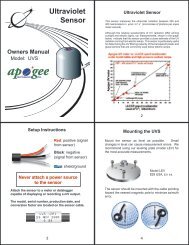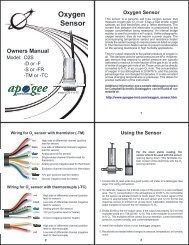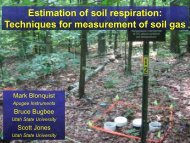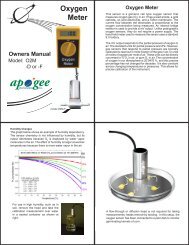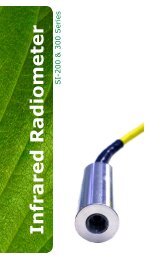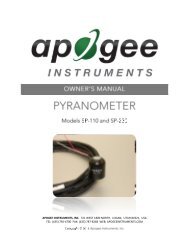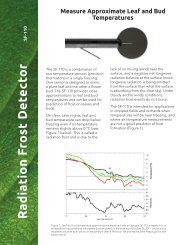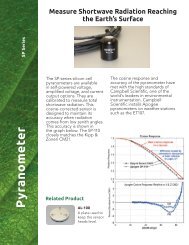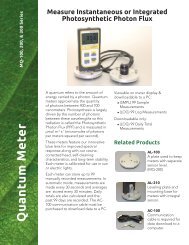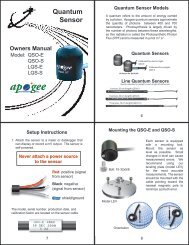Silicon Pyranometer - Apogee Instruments
Silicon Pyranometer - Apogee Instruments
Silicon Pyranometer - Apogee Instruments
Create successful ePaper yourself
Turn your PDF publications into a flip-book with our unique Google optimized e-Paper software.
Owners ManualModel: PYR-PPYR-S<strong>Silicon</strong><strong>Pyranometer</strong><strong>Pyranometer</strong> SensorThis sensor is calibrated to measuretotal shortwave radiation. Theevaporation of water from soil andthe transpiration of water from plantleaves are partly determined by theintensity of shortwave radiation, whichis measured in Joules m -2 s -1 orWatts m -2 .US Patent No. D519,8605 6Setup InstructionsMounting the PYR-S and PYR-PRed: positive (signalfrom sensor)Black: negative(signal from sensor)Clear: shield/groundNever attach a power sourceto the sensorAttach the sensor to a meter or dataloggercapable of displaying or recording a mV output.The model, serial number, production date, andconversion factor are located on the sensor cable.Bolt: 10-32x5/8Model LEVEach sensor is equippedwith a mounting bolt.Mount the sensor aslevel as possible. Smallchanges in level can causemeasurement errors. Werecommend using ourleveling plate (model LEV)for the most accuratemeasurements. The sensorshould be mounted with thecable pointing toward thenearest magnetic pole tominimize azimuth error.Orientation7 8
CalibrationModel PYR-P and PYR-S sensors have astandard calibration of exactly:5.00 W m -2 per mVSpectral Response and CalibrationAn ideal pyranometer measures the entire solarspectrum, 280 to 2800 nm. However, about 90% ofsunlight energy is between 300 to 1100 nm. ModelsPYR-P and PYR-S are calibrated to estimate all of theshortwave energy from sunlight. <strong>Apogee</strong> pyranometersare calibrated under sunlight over a multiple day periodto a heated and ventilated Kipp & Zonen model CM21precision reference radiometer.Use the conversion factor(5.00 W m -2 per mV) to convertthe mV signal from the sensorto shortwave radiation in Wattsm -2 (multiply the mV output bythe conversion factor to yieldshortwave radiation in W m -2 ).2Cosine ResponseSpecificationsPrecision (PYR-P) Standard (PYR-S)Cosine response 45° zenith angle ± 1 % ± 4 %75° zenith angle ± 4 % ± 10 %Absolute accuracy ± 5 % ± 8 %Uniformity ± 3 % ± 5 %Repeatability ± 1 % ± 2 %Output Responsivity 0.200 mV per W m -2In full sunlight 220 mV (1,100 W m -2 )Linear range 0 - 350 mV (0 - 1,750 W m -2 ); 1.75 x full sunSensitivityCustom calibrated to exactly 5.00 W m -2 per mVInput powerNone, self-poweredOperating environment- 40 to 55 °C; 0 to 100% relative humidity.Designed for continuous outdoor use. Can besubmerged under water.MaterialsAnodized aluminum with acrylic lensCable3 meters of shielded, twisted-pair wire withSantoprene casing, ending in pigtail leads.Additional cable $ 1.95/meter.Dimensions2.4 cm diameter, 2.75 cm highMass70 g (with 3 m lead wire)Warranty1 year parts and laborTemperature responseThe temperature response is less than 0.1% per degree Celsius.This temperature error is not significant in most applications.Long-term stabilityOur research indicates that the average output increases about1% per year because of changes in the optical transparency of thediffusion disk. We recommend returning the sensor for recalibrationevery 2 years.3 4435-792-4700www.apogeeinstruments.comtechsupport@apogee-inst.com


